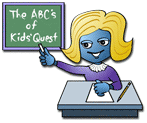 Glossary
Glossary
 Augmentative
or
alternative communication (AAC) device: An
electronic device that talks for a person who cannot speak. The device usually has
a recorded or electronic voice and can
say words or sentences the user chooses.
Augmentative
or
alternative communication (AAC) device: An
electronic device that talks for a person who cannot speak. The device usually has
a recorded or electronic voice and can
say words or sentences the user chooses.
 Assistive
devices and
technology:
Any piece of equipment, or product that a person with a disability can
use to increase, maintain, or improve his or her ability to do
things.
Assistive
devices and
technology:
Any piece of equipment, or product that a person with a disability can
use to increase, maintain, or improve his or her ability to do
things.
 Communication
limitations: Problems a person has with everyday
communication activities such as talking on the phone or ordering food at
a fast food resturant.
Communication
limitations: Problems a person has with everyday
communication activities such as talking on the phone or ordering food at
a fast food resturant.
 Disability:
A general term used for the problems a person with
a health condition (such as cerebral palsy or deafness) has because
of barriers in his or her environment.
Disability:
A general term used for the problems a person with
a health condition (such as cerebral palsy or deafness) has because
of barriers in his or her environment.
 Learning
limitations: Problems a person has with everyday
learning activities such as school work, learning to play a sport, or
learning a new job.
Learning
limitations: Problems a person has with everyday
learning activities such as school work, learning to play a sport, or
learning a new job.
 Mobility
limitations: Problems a person has with everyday mobility activities such as walking or getting
around or sitting.
Mobility
limitations: Problems a person has with everyday mobility activities such as walking or getting
around or sitting.
 Paralympics:
an international sports competition involving world-class
disabled athletes, similar in scope to the Olympic Games. The Paralympic
Games are held about 2 weeks after the Olympic Games in the same
host city/country.
Paralympics:
an international sports competition involving world-class
disabled athletes, similar in scope to the Olympic Games. The Paralympic
Games are held about 2 weeks after the Olympic Games in the same
host city/country.
 People
with disabilities:
People who have an activity limitation, use assistance,
or believe they have a disability.
People
with disabilities:
People who have an activity limitation, use assistance,
or believe they have a disability.
 Personal-care limitations: Problems
a person has with everyday personal-care activities such as dressing, going to
the bathroom or eating.
Personal-care limitations: Problems
a person has with everyday personal-care activities such as dressing, going to
the bathroom or eating.
 Secondary
conditions:
Secondary
conditions:
Medical, social, emotional, family, or community problems that a person
with a primary disabling condition (such as mental retardation or
blindness) probably experiences.
[Return to top of page]
Date: September 28, 2006
Content source: National Center on Birth Defects and Developmental
Disabilities